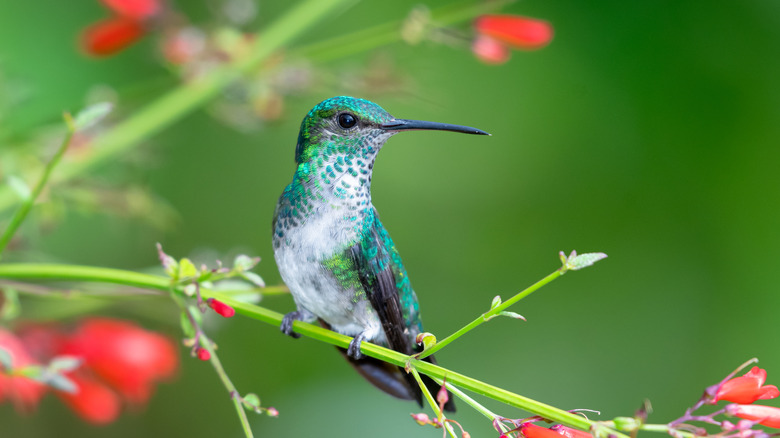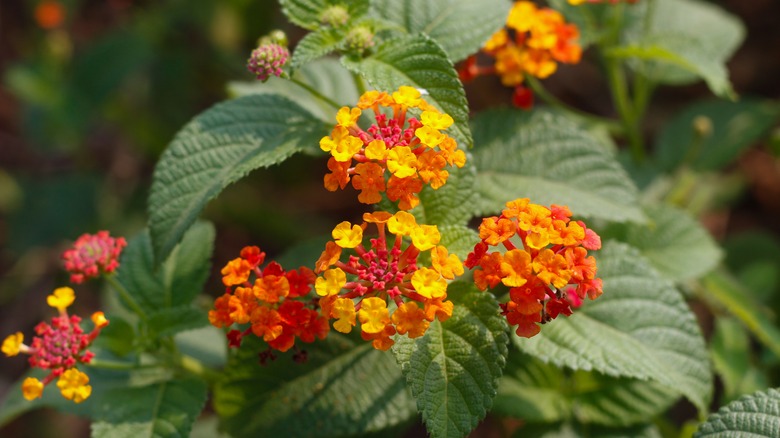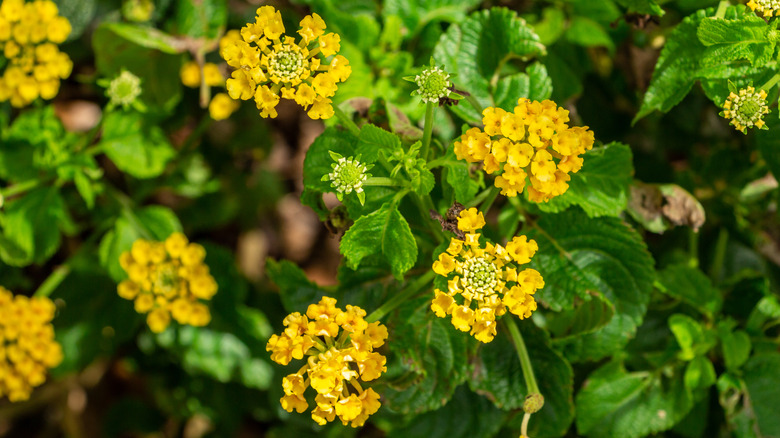The Vibrant Hummingbird-Attracting Flower You'll Regret Planting In Your Yard
You'll be hard-pressed to find a gardener who doesn't appreciate the magic hummingbirds weave. Shining iridescent in the sunlight, hovering on invisible threads, they poke through vibrant petals with their needle bills, leaving the garden (and our hearts) aflutter. However, creating an exquisite flower display from dry, parched soil isa tedious job — unless you're growing and taking care of lantana plants. Lantanas tend to be incredibly drought-resistant. Regrettably, not all lantana species deserve a place in your yard.
Clothed in golden, rosy, or bi-colored umbels, common lantana (Lantana camara) shrubs are colorful flowers that will bring bees into your yard, as well as butterflies and hummingbirds. For this reason, they're the top-selling variety, ubiquitous across big-box retailers and nurseries, to the chagrin of many southeastern states. Florida, Texas, and Hawaii recognize Lantana camara as an invasive weed and dissuade its establishment in gardens. It also features on the invasive lists of Alabama-, Georgia-, California-, and Apalachicola-based plant councils. Indeed, so sordid is its spreading that it has wound up on the global invasive species list, impacting over 60 nations.
Lantana camara harbors a thicket of problems
Native to Central and South America, Lantana camara has a history of battling the surrounding vegetation to death until it's the sole survivor, making it a huge nuisance in landscapes. After rooting, it releases toxins (allelochemicals) in the soil, terribly damaging neighboring leafy friends, if not killing them outright. Lantana camara's colonization knows no bounds, leveraging birds' fervor for its berries to expand its presence. That's also why homeowners remain ignorant of the danger, as they don't find many seeds in their yards. Nevertheless, once the birds poop out the seed, it helps break dormancy, stimulating growth in new areas. Research published by the Cambridge University Press also found that buried seeds can remain viable for nearly 11 years if the area receives adequate rainfall.
Worse, Lantana camara is a compulsive outcrosser, meaning it loves to breed with and thus destroy the native lantana species, including Florida's Lantana depressa. Plus, it's hard to eliminate since it behaves like a perennial weed, re-rooting through its adventitious roots unless dug out completely or frost-killed (in cooler climates), necessitating herbicide treatments. Moreover, the plant is through-and-through poisonous, causing contact dermatitis in adults while turning fatal for children. It's capable of harming pets, too, although sometimes its thickets may harbor rats.
Switch to sterile hybrids or native species
While the best course of action would be to stave off the Lantana camara variety, hummingbird lovers mustn't lose heart if they find it hard to let go of the gorgeous, tubular flowers. For starters, plenty of nurseries have started selling hybrid cultivars of the camara species, wherein they produce sterile seeds, making them safe for cultivation. For instance, 'Luscious Royale Red Zone,' 'Bloomify Red,' and 'Bloomify Rose' are some trademarked cultivars from the University of Florida. Other popular offerings include 'New Gold', 'Patriot,' 'Miss Huff,' 'Alba,' 'Cream Carpet,' 'Banana Yellow,' and 'Mozelle.'
Alternatively, you can plant the lantana species native to your state and zip code. For instance, Lantana depressa and Lantana involucrata are found in Florida, although the former should be grown only in southern pine rocklands and not across the state. Similarly, Lantana achyranthifolia is common in Texas and Arizona while Lantana urticoides is at home in North Carolina. Also, note that some nurseries sell 'Gold Mound' cultivar as the native Lantana depress, which isn't correct, per Roger L. Hammer's The Lantana Mess write-up. He explains that since the camara variety has muddied the depressa genes, it's ideal to steer clear of short, yellow-flowered varieties. Alternatively, you might want to consider other flowers that hummingbirds absolutely love, like dwarf pentas.


